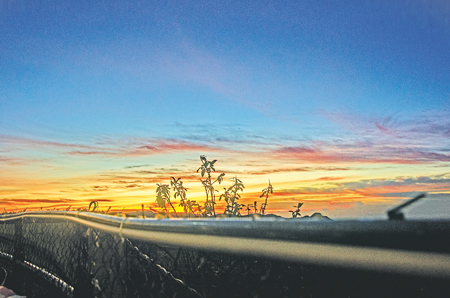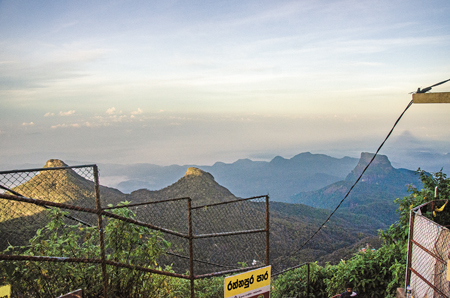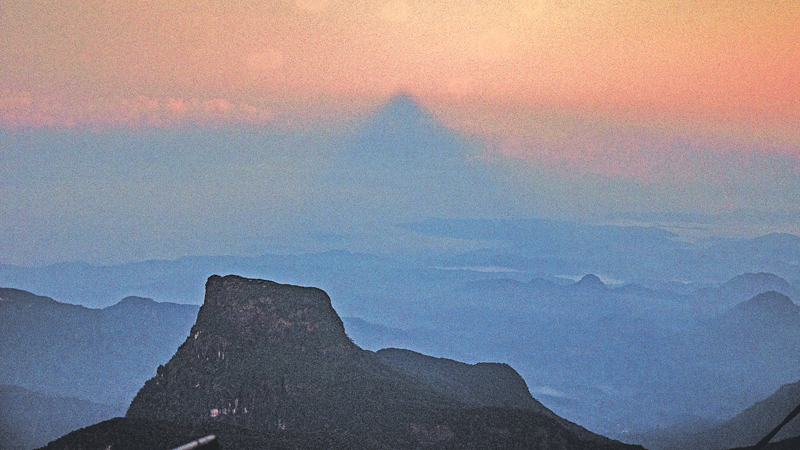 Ratnapura is the ‘classical’ gateway for the pilgrimage climb up 7,360-foot (2,243-metres) Sri Pada or Adam’s Peak. It is a 16 mile journey (or nine by vehicle and seven by foot) to the top of the pointed peak by this arduous route through the Carney Estate. The other route, from Maskeliya via Nallathanniya, begins at a much higher elevation and is a much easier ascent of about seven kilometres.
Ratnapura is the ‘classical’ gateway for the pilgrimage climb up 7,360-foot (2,243-metres) Sri Pada or Adam’s Peak. It is a 16 mile journey (or nine by vehicle and seven by foot) to the top of the pointed peak by this arduous route through the Carney Estate. The other route, from Maskeliya via Nallathanniya, begins at a much higher elevation and is a much easier ascent of about seven kilometres.
All four major religions of Sri Lanka say that Adam’s Peak is a holy mountain. Buddhists call the mountain Sri Pada (‘the sacred footprint’) and say it was visited by Gautama Buddha himself. An early name given to the mountain is Samanala Kanda, ‘Saman’s Hill’ Since before Buddhism arrived in the island, the deity Saman has been regarded as supreme here.

The first rays of the sun from the summit of Sri Pada
At least since the 11th Century, the mountain has been a goal of pilgrims. King Vijayabahu I and King Nissanka Malla of Polonnaruwa both recorded their pilgrimage here. The Mahawamsa made reference to the Buddha’s foot-print atop the mountain.
The pilgrimage season begins in December and continues until the Vesak Full Moon Poya in May. It is at its height in March. At other times, the mountain is bleak and rains make the trail dangerous. Tens of thousands of pilgrims make the journey every year. Most of them climb at night up a staircase illuminated by electric lamps. Frequent Ambalamas (pilgrim’s rests) and refreshment stalls make the climb easier. Those who reach the summit by dawn witness the first rays of the morning sun is bliss. You feel you are in heaven on earth and an almost supernatural spectacle: the magnified, triangular shadow of the peak itself superimposed on the awakening country-side.
Unique traditions
Adam’s Peak pilgrims follow a number of unique traditions in their ascent. It is customary for first-time climbers (Kodu) to pile great turbans of white cloth on their heads. On both main routes, at the Seethagangula, one should dip in chilled water and the Indikatupana (‘place of the needle’) demands the devout to stop and fling a threaded needle into shrub by the side of the path.
At the summit, a bell clangs unceasingly, reverently tolled by old man and toddler alike, to signify a pilgrimage completed. (The current journey may not be tallied, for it is not complete until one returns home.) It is bad form, by the way, to ask how far it is to the top. Instead, just exchange the greeting karunawai – peace.

‘Bena Samanala’ the twin peaks that stand to the right of
Kunudiya Parwathaya hill.
To climb the 2,243-metres (7,360-foot) high Sri Pada holy mountain and photograph the sunrise Era Sewaya from the summit of Sri Pada peak had long been a cherished ambition of mine. For most of my life, it remained out of reach due to an ailment of my right leg. From my childhood, I had been to the summit on two occasions on a pilgrimage with my grandmother.
As a photographer, I had an opportunity to capture the magnificent sunrise on my recent pilgrimage to the summit with my elder son and my younger brother.
We selected the most arduous but beautiful trail of Kuruwita-Erathna. This trail is much more difficult to tread than the most popular Hatton-Nallathanni route. The path is a rough track with boulders and rocks except for a few places with steps.
Our journey began from a small town called Kuruwita on A4 highway close to Ratnapura. To start the trek, we travelled 11 kilometres from Kuruwita by bus to a small hamlet called Adavikanda, the final town of the sleepy village of Erathna. Proceeded Erathna about 1.5 km to reach the trailhead at Adavikanda. During the Sri Pada season, the bus service extended up to Adavikanda. The road abruptly ended at a car park next to the trail where you can stop before trekking to purchase snacks and drinks from vendors here.
We started our trek at 7pm. from Adavikanda knotting a vow to God Saman at a small shrine to protect us from evil happening. During our 18- hour trek, we made prolonged stops at all Ambalamas along the way. The weather was perfect.
Ambalamas
There are a number of Ambalamas alongside the Sri Pada trek in all three major routes. Holy mountain has been climbed for thousands of years by kings and pilgrims alike. They have, since ancient times, built places to rest, eat and sleep. And now they’ve evolved into shelters renovated by the devotees around the island. These places are pretty simple and don’t contain furniture or any other luxuries. Most of these places have small stores attached to them that sell necessities for pilgrims.
The trail started with a brief flat section but soon turned into a continuous climb. There were no concrete staircases at all, instead, only a rough footpath with steep climbing. In the early stages of the climb, we heard the gushing waters of Kuru Ganga which sprang from the peak wilderness, flowing alongside the footpath through the forest canopy.
Having travelled about one hour, we reached the first resting place (Ambalama) known as Jambolagaha-Yata Ambalama. We rested a moment here and had our meal there. We recommend pilgrims to stop a few moments as the climb does not get any easier past this point. Looking around we noticed massive mountains rising above the forest reserve.

The Warnagala waterfalls
After climbing around two kilometres and 780 m above the sea level, we reached the second Ambalama called Diamondgala. Passing this point, we reached Warnagala Mountain, one of the most beautiful localities of the trail. A large rock bed equipped with railings eased our climbing. We enjoyed and admired the scenic beauty of nature.
Passing a small bridge above sloping bedrock, we heard the calming sounds of a waterfall. This was Warnagala Falls. To reach this, we crossed a footpath just outside the Police Post of Warnagala and walked around 200 metres down to the stream. Warnagla Falls’s beauty is seen during the rainy season which is also the off-season for Sri Pada pilgrimages.
Passing this point, we were trekking among mostly flat forested terrain – passing through pretty flora and fauna surrounding the path. After about 5 km from the trail, we reached another Ambalama at the Seetha Gangula.
This icy cold stream full of pebbles is an amazing place among pilgrims as it crosses three of the trails to Sri Pada. A line is attached to cross the stream which isn’t deep at all during the dry season. Crossing it in the rainy-season would be highly challenging. It’s a perfect place to have a dip if you can endure frigid water and first climbers must have a bath here applying lime on their heads before starting the trek.
Wonderful sights
As we continued forward on the rocky steps, we reached a significant landmark on the trail – the Idikatupana, a large natural bedrock protrusion featuring wonderful sights of the surrounding terrain with Kunudiya Parwathaya, a massive hill, loomed back. Looking ahead, we got the first glimpse of the majestic mist-laden Sri Pada peak looming like a pinnacle in the sky. However, 700 metres of climbing lies ahead to reach the summit.
The path becomes strenuous and rocky until you reach the next significant resting place after 1.2 kilometres at 1,800 metres above sea level. The transformation of the flora is quite apparent here as the trees become shorter and more spread out.
Another resting place known as Galwangediya is a memorable location because the Kuruwita-Erathna trail joined here with Ratnapura-Palabathgala trail. We stopped here to take our dinner from the eating house at this junction. It was worth stopping for us to have delicious food available at reasonable prices.

Seethagagula near Gangulathenna on the Erathna trail
The actual climb of the peak begins beyond this junction. The gravel replaced by cement steps with handrails. The last Ambalama we found was Andiyamalatenna. Located about one kilometre from the Galwangediya, this Ambalama is pretty large and used by pilgrims for over-night stays. When you pass this, the path continues its steep ascent and eventually reaches a junction where a path branches to the left from the stairway.
We continued straight up and admired the scenic view. Nearby mountains appeared like guardian angels of the holy peak. Most prominent of these are the Bena Samanala mountains and peculiarly shaped Kunudiya Parwathaya hill; those twin peaks stand to the right.
After about ½ hour of climbing, we reached the steepest section of the trail called Mahagiridambaya. We heard the continuous sound of the ringing the bell and tape-recorded Buddhist chants emanating from a loudspeaker atop the mountaintop temple.
This section was a near vertical rock face with challenging steps sure to slow down our progress. In earlier days, chains were used to conquer this unforgiving rock face; these are still visible by the side of the trail. Thanks to the railings and stairs trekkers don’t need to be experts in technical rock climbing to get past this barrier.
Chilly temperature
We finally reached the summit of the Sri Pada peak around 12.40 am. We worshipped the Buddha’s Sacred Footprint and began to rest another 4 hours sitting on the staircase under the chilly temperature on the summit hoping to watch the magnificent sunrise from the summit.
Around 5.30 am, visitors were running here and there to find a better view point to catch the glimpses of the sunrise.
Around 6.am the entire Eastern horizon turned into red and yellow warm colours. Atop the summit, we witnessed the first rays of the sun and the beginning of a new day. Suddenly, another phenomenon happened on the Western side of the peak. Just as the sun came out the pyramid shadow appeared as the sun lines up behind Sri Pada. It floated rather than conforms to the lie of the land beneath. The triangle was perfect. Its colour deepened, quickly faded and was gone.







